Abstract
OBJECTIVE: To examine whether male and female family physicians practise maternity care differently, particularly regarding the maternal serum screening (MSS) program. DESIGN: Mailed survey fielded between October 1994 and March 1995. SETTING: Ontario family practices. PARTICIPANTS: Random sample of 2000 members of the College of Family Physicians of Canada who care for pregnant women. More than 90% of eligible physicians responded. MAIN OUTCOME MEASURES: Attitudes toward, knowledge about, and behaviour toward MSS. RESULTS: Women physicians were more likely than men to practise part time, in groups, and in larger communities. Men physicians were more likely to perform deliveries; women were more likely to do shared care. Despite a shorter work week, on average, female physicians cared for more pregnant women than male physicians did. Among those providing intrapartum care, women performed more deliveries, on average, than men. Women physicians were more likely than men to offer MSS to all pregnant patients. Although average time spent discussing MSS before the test was similar, women physicians had better knowledge of when best to do the test and its true-positive rate. All differences reported were statistically significant (P < or = 0.001). CONCLUSIONS: Among family physicians caring for pregnant women, women physicians cared for more pregnant women than men did. Both spent similar time discussing MSS with their patients before offering screening, but more women physicians offered MSS to all their patients and were more knowledgeable about MSS than men physicians.
Full text
PDF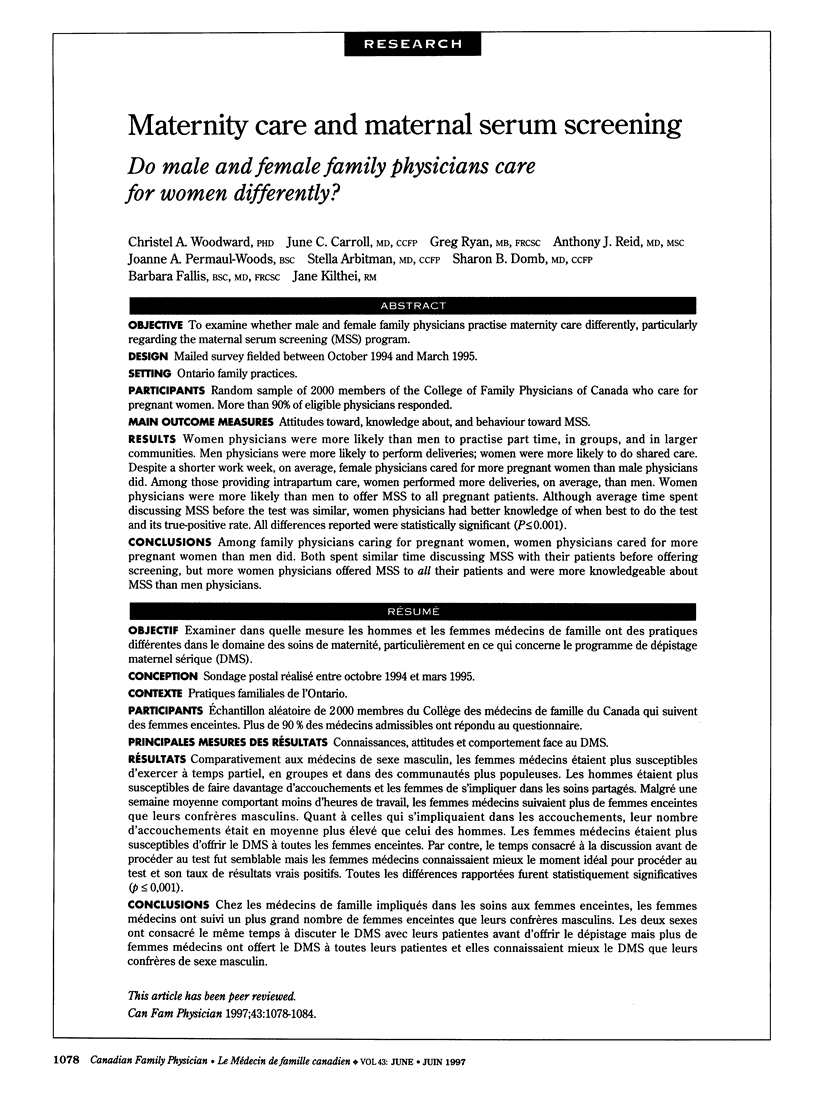
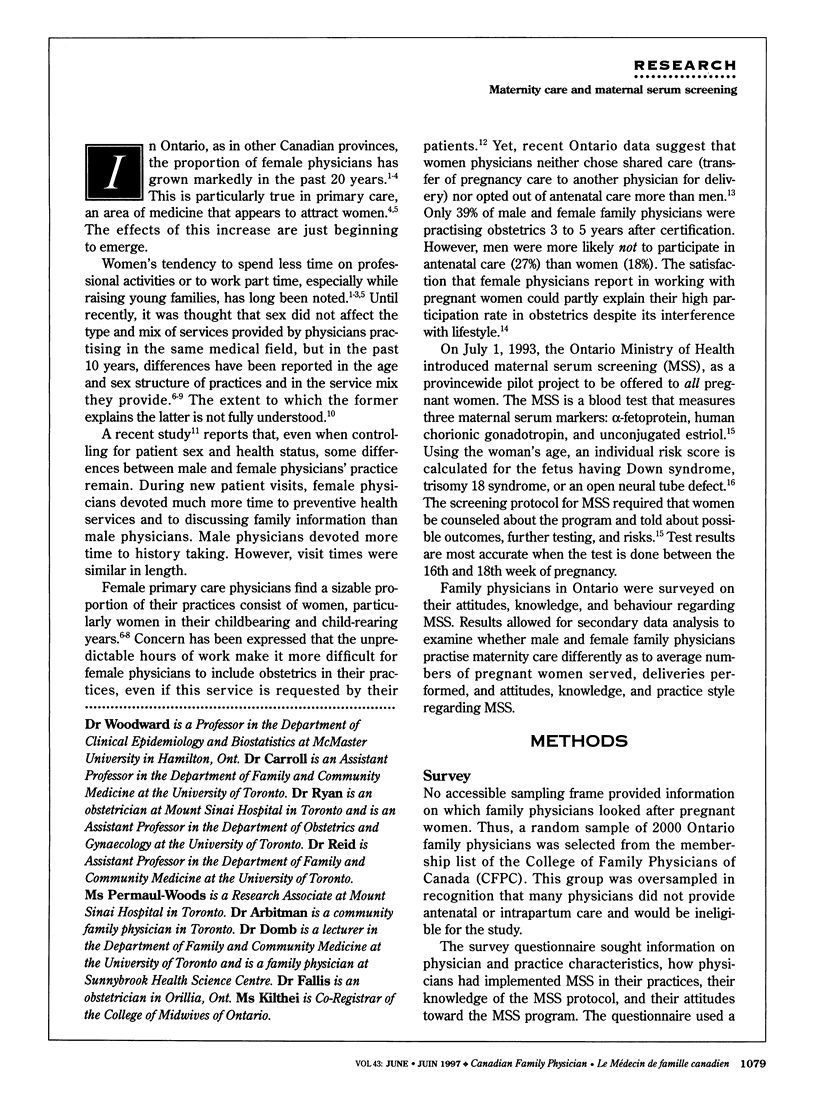
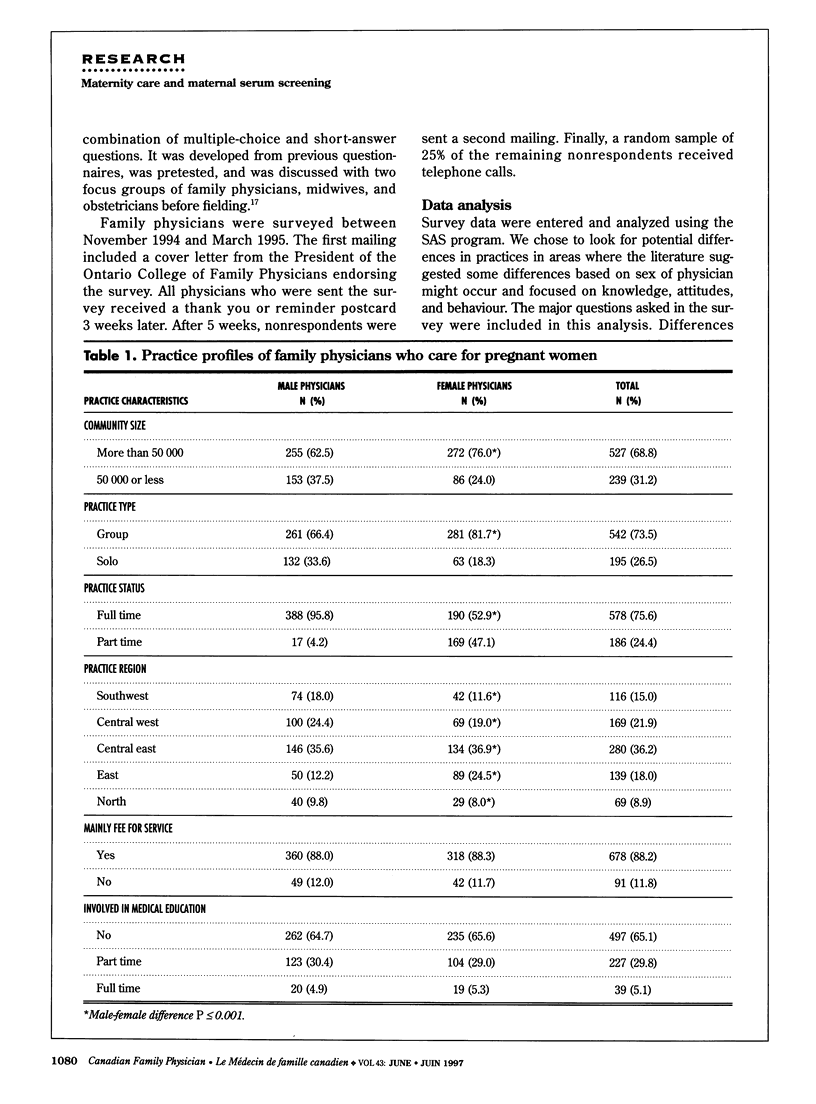
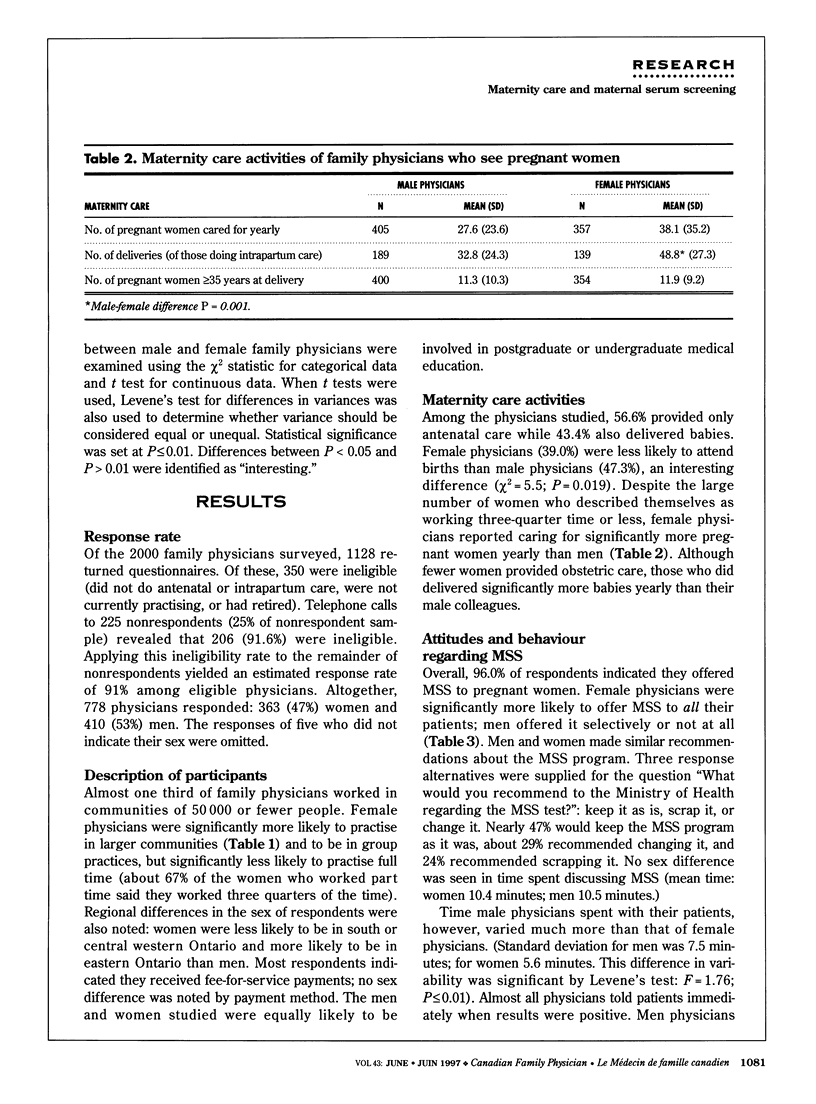

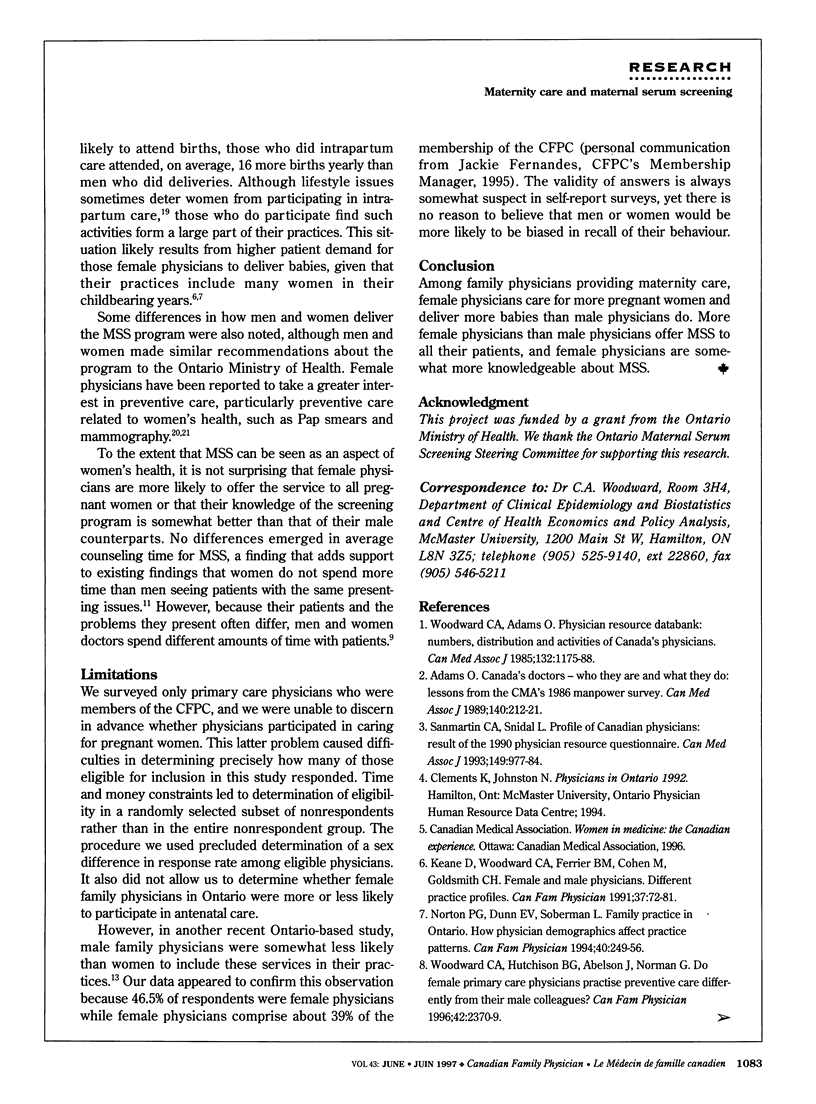
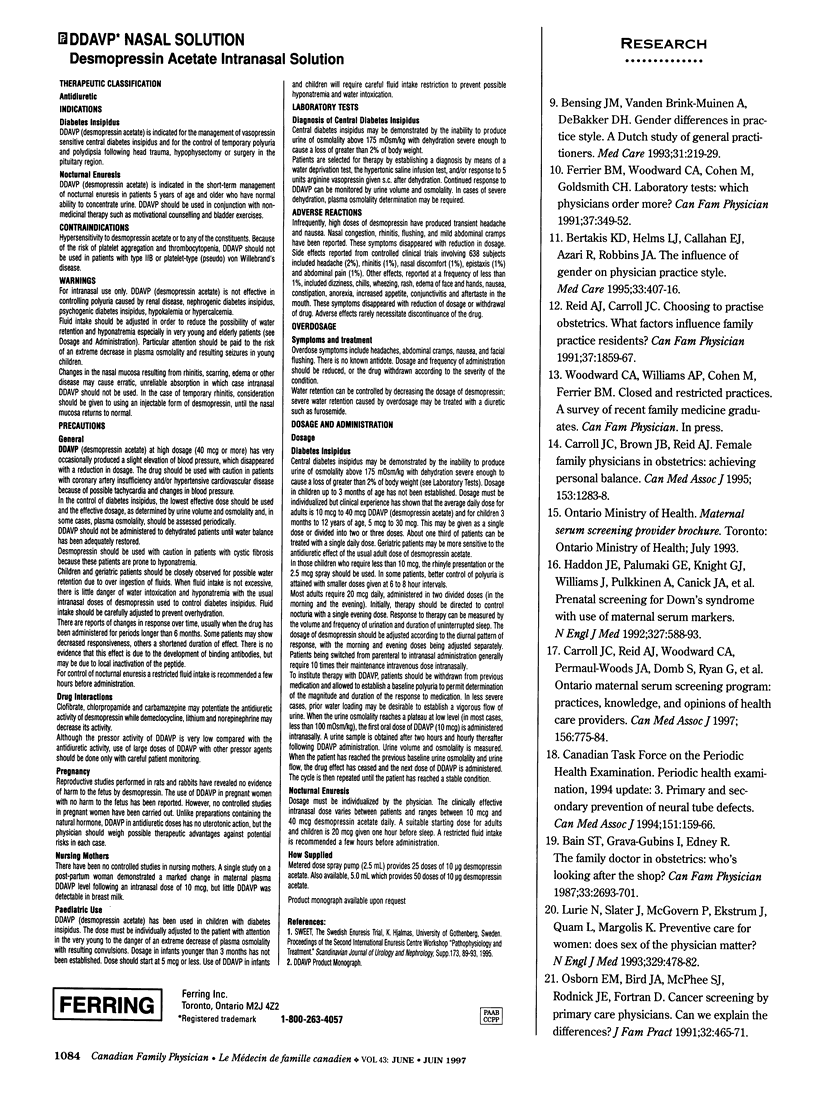
Selected References
These references are in PubMed. This may not be the complete list of references from this article.
- Adams O. Canada's doctors--who they are and what they do: lessons from the CMA's 1986 manpower survey. CMAJ. 1989 Jan 15;140(2):212–221. [PMC free article] [PubMed] [Google Scholar]
- Bain S. T., Grava-Gubins I., Edney R. The Family Doctor in Obstetrics: Who's Looking after the Shop? Can Fam Physician. 1987 Dec;33:2693–2701. [PMC free article] [PubMed] [Google Scholar]
- Bensing J. M., van den Brink-Muinen A., de Bakker D. H. Gender differences in practice style: a Dutch study of general practitioners. Med Care. 1993 Mar;31(3):219–229. doi: 10.1097/00005650-199303000-00004. [DOI] [PubMed] [Google Scholar]
- Bertakis K. D., Helms L. J., Callahan E. J., Azari R., Robbins J. A. The influence of gender on physician practice style. Med Care. 1995 Apr;33(4):407–416. doi: 10.1097/00005650-199504000-00007. [DOI] [PubMed] [Google Scholar]
- Carroll J. C., Brown J. B., Reid A. J. Female family physicians in obstetrics: achieving personal balance. CMAJ. 1995 Nov 1;153(9):1283–1289. [PMC free article] [PubMed] [Google Scholar]
- Carroll J. C., Reid A. J., Woodward C. A., Permaul-Woods J. A., Domb S., Ryan G., Arbitman S., Fallis B., Kilthei J. Ontario Maternal Serum Screening Program: practices, knowledge and opinions of health care providers. CMAJ. 1997 Mar 15;156(6):775–784. [PMC free article] [PubMed] [Google Scholar]
- Ferrier B. M., Woodward C. A., Cohen M., Goldsmith C. H. Laboratory Tests: Which Physicians Order More?: How women's practices differ from men's. Can Fam Physician. 1991 Feb;37:349–352. [PMC free article] [PubMed] [Google Scholar]
- Haddow J. E., Palomaki G. E., Knight G. J., Williams J., Pulkkinen A., Canick J. A., Saller D. N., Jr, Bowers G. B. Prenatal screening for Down's syndrome with use of maternal serum markers. N Engl J Med. 1992 Aug 27;327(9):588–593. doi: 10.1056/NEJM199208273270902. [DOI] [PubMed] [Google Scholar]
- Keane D., Woodward C. A., Ferrier B. M., Cohen M., Goldsmith C. H. Female and Male Physicians: Different Practice Profiles: Will increasing numbers of female GPs affect practice patterns of the future? Can Fam Physician. 1991 Jan;37:72–81. [PMC free article] [PubMed] [Google Scholar]
- Lurie N., Slater J., McGovern P., Ekstrum J., Quam L., Margolis K. Preventive care for women. Does the sex of the physician matter? N Engl J Med. 1993 Aug 12;329(7):478–482. doi: 10.1056/NEJM199308123290707. [DOI] [PubMed] [Google Scholar]
- Norton P. G., Dunn E. V., Soberman L. Family practice in Ontario. How physician demographics affect practice patterns. Can Fam Physician. 1994 Feb;40:249–256. [PMC free article] [PubMed] [Google Scholar]
- Osborn E. H., Bird J. A., McPhee S. J., Rodnick J. E., Fordham D. Cancer screening by primary care physicians. Can we explain the differences? J Fam Pract. 1991 May;32(5):465–471. [PubMed] [Google Scholar]
- Reid A. J., Carroll J. C. Choosing to Practise Obstetrics: What factors influence family practice residents? Can Fam Physician. 1991 Sep;37:1859–1867. [PMC free article] [PubMed] [Google Scholar]
- Sanmartin C. A., Snidal L. Profile of Canadian physicians: results of the 1990 Physician Resource Questionnaire. CMAJ. 1993 Oct 1;149(7):977–984. [PMC free article] [PubMed] [Google Scholar]
- Woodward C. A., Hutchison B. G., Abelson J., Norman G. Do female primary care physicians practise preventive care differently from their male colleagues? Can Fam Physician. 1996 Dec;42:2370–2379. [PMC free article] [PubMed] [Google Scholar]
- Woodward C., Adams O. Physician resource databank: numbers, distribution and activities of Canada's physicians. Can Med Assoc J. 1985 May 15;132(10):1175-9, 1182-8. [PMC free article] [PubMed] [Google Scholar]


